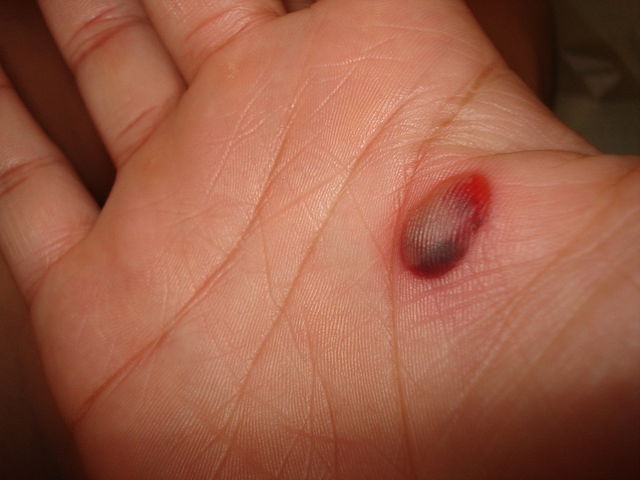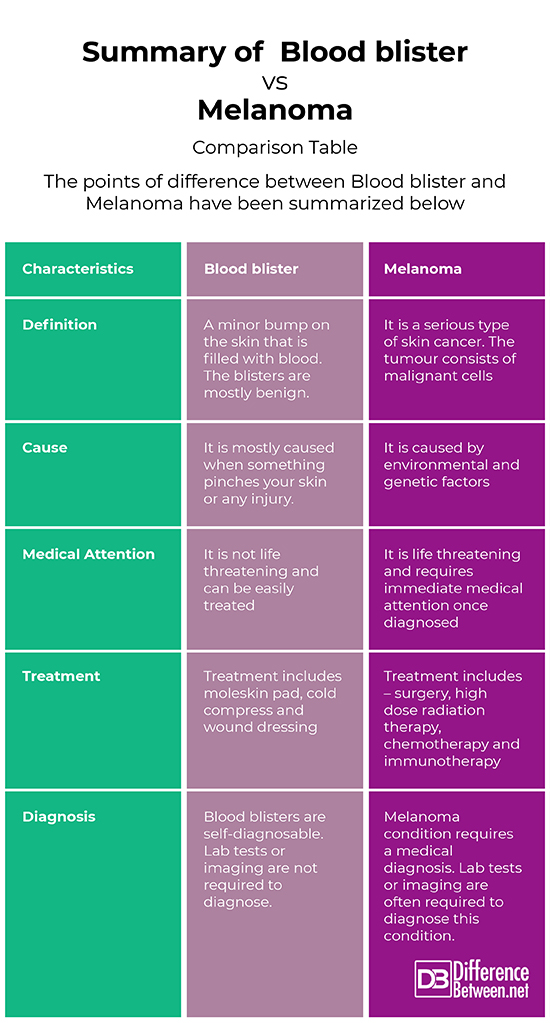Difference between Blood blister and Melanoma
What is Blood Blister and Melanoma?
Blood blisters are like normal blisters that are caused due to pinching of skin.
Melanoma is a serious type of cancer of skin.
Initially it does look like a normal blood blister but the two are different medical conditions. Former is self-treatable and the latter needs medical attention and proper medical treatment.
What is Blood blister?
A blood blister occurs when the subdermal tissues are destructed without piercing the skin. So, when the skin is pinched, bruised and rubbed, a blood blister will form. A blood blister appears like a blood-filled ball covered by skin.
The presence of blood in a blister shows the presence of high pressure component. Unlike friction blisters which contain a clear fluid, blood blisters comprise of a red liquid. The fluid begins as a light red color that appears darker after some time. Most of the blood blisters cause minor discomfort and irritation. However, some blisters are extremely painful in case there is infection.
It is usually self-diagnosable and heals on its own in 1-2 weeks, but needs medical attention in case there is severe infection. Applying antibiotic cream over the blister helps to heel it faster.
What is Melanoma?
Melanoma is the most dangerous form of skin cancer. The malign tumours grow when the unrepaired Deoxyribonucleic acid damage to the cells of the skin causes mutations. These mutations cause the damaged skin cells to multiply rapidly and develop malignant tumours. This damage to the skin is mostly caused due to UV rays form sunshine or tanning beds.
Melanoma grows when the pigment-producing cells which are responsible to give colour to the skin becomes malign or cancerous.
The probability of developing a melanoma increases with age. It is the most commonly registered cancer in men aged between twenty-five – forty-four and the 2nd most commonly registered cancer in women between the same age group.
When the doctors assess a suspicious mole, blister or freckle, they mostly use the below given assessment criteria:
ABCDE of melanoma:
A for Asymmetrical shape – Melanoma moles are not regular and symmetrical
B for Border – the border of the Melanoma lesions or freckle is irregular
C for Colour – uneven distribution of colour (blue, black, brown, tan etc)
D for Diameter – Melanoma mole is greater than six mm in diameter
E for Evolution – Melanoma lesion is enlarging or changing
Glasgow 7-point checklist (7PCL):
Change in size of the mole
Shape is not regular
Irregular pigmentation
Diameter > 7mm
Inflammation
Itch or altered sensation
Border is not regular
Difference between Blood blister and Melanoma
Definition
Blood blister
It is a raised, blood-filled sack on the skin.
Melanoma
It is a serious type of skin cancer.
Causes
Blood blister
- Blood blisters are caused when something pinches your skin
- Your hand caught in a door jamb
- Wearing ill-fitted shoes that rub your skin
- Viral infections – like chickenpox or shingles
Melanoma
- Melanoma is caused when the pigment-producing cells which give colour to the skin become malignant or cancerous
- A weak immune system
- A family history of unusual moles or melanoma
- Xeroderma pigmentosum – a rare genetic medical condition that stops the skin from repairing itself from Ultra Violet damage
- Exposure to radiation, and some chemicals (e.g. solvents)
Symptoms
Blood blister
- The blister looks like a friction blister
- Blister may be red, purplish or even black in colour
- Minor irritation at the site of the blister
Melanoma
- Hard lumps beneath the skin
- Pain in the bones
- Advancement of pigment from the border of a spot to the surrounding skin
- Change in the mole colour
- Itchiness, redness, tenderness and pain
- Oozing of blood from the mole
- Scaliness and change in the surface of the mole
- Height if the mole elevates and enlarges
- Inflammation
- Vision gets blurred or there is partial loss of sight, or even dark spots in the iris
Methods to reduce risk factors
Blood blister
- Wear proper thick gloves when working with machines and tools or lifting heavy weights
- In order to avoid blood blisters in feet, it is important to keep feet dry
- Avoid wearing tight and uncomfortable shoes that do not fit.
Melanoma
- Protect yourself from ultraviolet (UV) light exposure
- People with fair skin, freckling, and light hair should keep monitoring their moles, any warts or lumps as they are at greater risk of getting melanoma.
- People with weak immune system should take extra care.
Treatment
Blood blister
- Apply ice to the blood blister
- Gently apply Aloe Vera gel to the blood blister for easing pain and swelling
- Do not attempt to pop blood blister in order to avoid infection
- Avoid to put pressure on the blister by wearing open-toe footwear.
- Keep the area clean and exposed to air for faster healing
- Protect the blister with a loose bandage for additional protection
- Wrap the blister loosely to help avoid additional friction
- Seek medical attention when required
Melanoma
- Common medications used for melanoma include DTIC – Dome (dacarbazine), which is the only FDA-approved chemotherapy for melanoma. Methazolastone, Temodar (Temozolomide) is an oral version of DTIC, which is used for the treatment of stage four melanoma.
- High dose radiation therapy
- Surgery to remove tumours
- Use of drugs that stimulate the body’s immune system to fight the melanoma. This treatment process is called immunotherapy
Summary of Blood blister Vs. Melanoma : Comparison Table
The points of difference between Blood blister and Melanoma have been summarized below:
- Difference Between Vaccination and Immunization - March 3, 2024
- Difference Between Selective Mutism and Autism - February 25, 2024
- Difference Between Depersonalization-Derealization and Dissociation - January 18, 2024
Search DifferenceBetween.net :
Leave a Response
References :
[0]Leatherman, M. (2004). What Caused a “Blood Blister” to Develop? Advances in skin & wound care, 17(7), 341.
[1]Michailidis, L., May, K., & Wraight, P. (2013). blister management guidelines: collecting the evidence. Wound Practice & Research: Journal of the Australian Wound Management Association, 21(1), 16.
[2]Riker, A. I., Zea, N., & Trinh, T. (2010). The epidemiology, prevention, and detection of melanoma. The Ochsner Journal, 10(2), 56-65.
[3]Image credit: https://upload.wikimedia.org/wikipedia/commons/thumb/b/bc/Melanoma_%284%29.jpg/587px-Melanoma_%284%29.jpg
[4]Image credit: https://upload.wikimedia.org/wikipedia/commons/thumb/7/71/Blood_blister_close-up_2_by_Esinam.jpg/640px-Blood_blister_close-up_2_by_Esinam.jpg
[5]Image credit: https://upload.wikimedia.org/wikipedia/commons/thumb/7/71/Blood_blister_close-up_2_by_Esinam.jpg/640px-Blood_blister_close-up_2_by_Esinam.jpg



